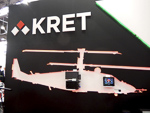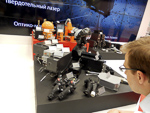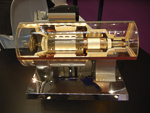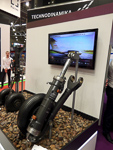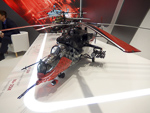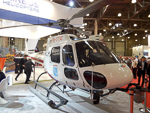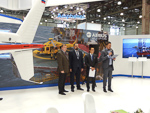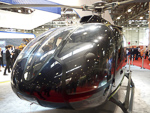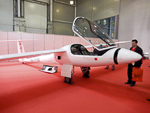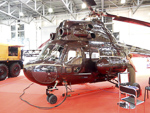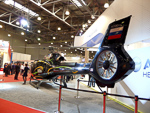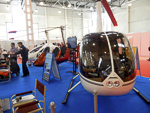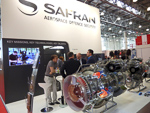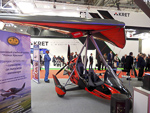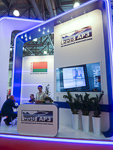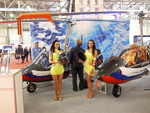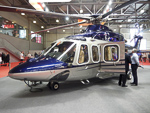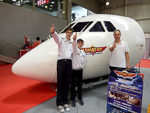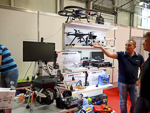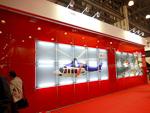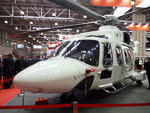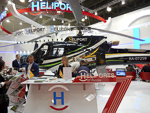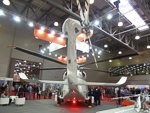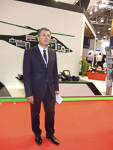During his speech at the opening of HeliRussia’2015, Russian Helicopters CEO Alexander Mikheev said that the current backlog stands at 585 helicopters worth 490 billion rubles. This year 244 helicopters will be delivered (67% of them (in monetary terms) will be exported). «There are no delays,» he stated. Alexander Alexandrovich believes that the general economic model of Russian Helicopters remains “more or less predictable” even in this difficult situation. «Problems are also predictable and so we have time and opportunity to find solutions».
Among problems faced by Russian companies Mikheev named «cost of credits, inflation development, consequences of escalation of global tensions» and added that they affect the whole economy of Russia. «Today we can’t say that the future is bright, that the helicopter industry is on easy street. In fact we are dealing with the same conditions as other Russian enterprises and all of Russia’s industries. However, we have a lot of export contracts. We are compensating losses caused by problems in the Russian economy thanks to foreign currency earnings».
Mikheev did not hide his satisfactions with recent success. The major milestone is agreement for development of a heavy helicopter in cooperation with Chinese partners from AVIC signed on May 8th 2015 in the presence of the President of Russia Vladimir Vladimirovich Putin and the President of People’s Republic of China, Xi Jinping. The vehicle was designated “Advanced Heavy Lift Helicopter”; it will be manufactured in China. The parties expect to secure about 200 orders for this vehicle with deliveries through 2040. Maximum takeoff weight of the AHL will be around 38 tons, payload – up to 10 tons inside the cabin or 15 tons – on an external sling. Meanwhile, Mi-26T2 (its mass production is being launched by Rostvertol), has a takeoff weight of 56 tons and it is able to carry a payload of 20 tons. So AHL will complement Mi-26T2 instead of competing with it; the new vehicle is going to occupy a niche, which became available after putting Mi-6 and Mi-10 helicopters out of operation.
The flight testing of Mi-171A2 helicopter fitted with KBO-17 avionics suite (one helicopter of the type was showcased near the entrance to an exhibition pavilion) as well as Mi-38 is being completed. According to Mikheev, four Mi-38 prototypes are taking part in the flight test program; certification tests should be completed this year. Addition of these vehicles to the product line of Russian Helicopters will help strengthen the company’s leading positions at the global market in the segment of helicopters having a takeoff weight of 13-16 tons and carrying from 24 to 30 passengers.
Another recent important milestone is obtaining (expanding) the AR IAC type certificates for Ansat and Ka-226T helicopters, which allows commercial operators to operate the vehicles, including passenger transportation (nominal passenger capacity of Ansat is 10 persons, Ka-226T – six persons). Presentation of the certificates to top managers of Russian Helicopters Holding Company was the most important event of the first day of HeliRussia’2015. Finally these troubled vehicles qualified for commercial operation!
Market has already showed interest in Ansat. On May 22nd right at the exhibition two operators – Tulpar Helicopters and Aviatsionno-Promishlennaya Kompaniya Vektor (Aviation and Industrial Company Vector) signed agreements for delivery of a total of 5 vehicles of the type.
«Over a long period of time the niche of indigenous light civil helicopters was occupied only by Mi-2 vehicles developed in Soviet era (maximum takeoff weight – 3700 kg, passenger capacity – nine persons). Russian Helicopters managed to develop a unique state-of-the-art Ansat helicopter, which has several significant advantages, – Alexander Mikheev said. – We are glad that Ansat has found its first customers and we hope that the order backlog will soon increase thanks to interest of foreign operators».
Situation with Ka-226T is developing in the network of military-technical cooperation between Russia and India. Ambassador Extraordinary and Plenipotentiary of India in Moscow, Pundi Srinivasan Raghavan, confirmed a recent decision to start assembly of Ka-226T helicopters at HAL enterprises under Russian license. This is about a great number of vehicles. It is expected that the first contract will include deliveries of 197-200 helicopters; India may require up to 500 vehicles of the type.
In the network of the tender Ka-226T were tested under different conditions in Russia and India, including flights performed in mountainous regions at high altitudes, because India is going to use the vehicles in the Himalayas. Despite the fact that this tender was cancelled by Indian Ministry of Defense (organizer of the tender) the results of these tests paved the way for accepting the Russia’s offer related to starting the licensed production of Ka-226T in India. The Indian government made the decision during visit of the President of Russian Federation Vladimir Putin to Delhi in December 2014.
The next one is Russian medium helicopter - Ka-62 having a passenger capacity of 12-14 persons; it is powered by Ardiden 3G engines (Turbomeca, France) and fitted with fuel system made by Zodiac Aerospace and Austrian transmission (Zoerkler Gears GmbH & Co KG). In terms of maximum takeoff weight the vehicle (6500 kg) outmatches Ansat (3300 kg, for the new version – 3600 kg) and Ka-226T (3600 kg).
Russian Helicopters have signed contracts for delivery of Ka-62 helicopters, including contracts with Atlas Taxi Aereo (Brazil) and Vertical de Aviacion (Columbia). Three prototypes intended for certification testing have already been manufactured; foreign suppliers have already delivered all the required components to the manufacturer. «I hope that foreign partners will be interested in this helicopter too, - Mikheev said. – Relationship with our western partners remain the same, because Ka-62 is a civil helicopter, so there are no restrictions connected with sanctions… We understand that there are some delays, but we used a lot of new technical solutions. We understand the situation and control our suppliers and copartners … I think that the vehicle will perform its maiden flight this year».
Alexander Mikheev also stressed the importance of commercialization of projects for development of medium helicopters (we’ll discuss the classification later): «the decrease of output of our plants may be compensated by bringing new models to the market and provision of high-quality MRO services. Over the last few years we have filled the market thanks to deliveries of our vehicles in the network of State Defense Order and export contracts signed by Rosoboronexport. Now our goal is to provide after-sales support and assure continued airworthiness of the global fleet of Mi and Ka helicopters. In order to secure a share of 20% at the global market we will develop our programs in the area of after-sales support. We are going o bring new models to the market as well. So we’ll make this “gap” smaller». We remind you that last year Russian Helicopters delivered 271 helicopters to the customers (and 275 ones – in 2013). The company should deliver 244 vehicles in 2015. The company holds the second place in terms of deliveries after Airbus Helicopters (in 2014 - 471 helicopters were delivered, mostly light and medium ones).
The overall picture
Before we continue the story about HeliRussia’2015, I would like to explain some terms. «Super-heavy», «heavy», «medium», «light», «ultra-light» aircraft – are relatives. Different countries use different classification. Historically, our country classifies all the helicopters lighter than Mi-8 (which is classified as “medium”) as “light”, including these relatively new vehicles: Ka-62, Ka-226 and Ansat. Western countries classify Mi-8 as “heavy” helicopter, and Ka-62, Ka-226 and Ansat as “medium” rather than “light”. In this classification the “light” helicopters are Mi-34S, «Aktai», Ka-115, AP-55.
Soviet and then Russian helicopters are known for their reliability, durability and ease of operation; the vehicles are able to work under any climatic condition and they don’t need to be parked in hangars. This statement refers mostly to heavy (Mi-8/17 Family, Ka-32) and super-heavy helicopters (Mi-6, Mi-10, Mi-26), as well as combat (Mi-24/35, Mi-28) and carrier-based (Ka-27/28/31) vehicles. These helicopters and services offered by their operators are in demand.
However, medium and light vehicles developed in Russia are, like in reports of USSR information bureaus in 1941, “engaged in a tough battle with superior enemy forces”, losing one position after another. The western forces are represented by such famous companies as Airbus Helicopters, AgustaWestland, Bell, Robinson, etc. They manufacture excellent products, which in fact outmatch the Russian analogues. For many years they were investing a lot of money in development of their product line in light and medium segments and today they are “receiving dividends”.
It’s hard to compete with them, but it is possible. Example – victory of Ka-226T in the tender for delivery of multi-role helicopters to Indian armed forces (we will surely talk about this unique vehicle and its future in our next articles). But the question is: do we need to view the western companies only as rivals? If it is hard for us to compete with them in some segments, maybe it’s easier to find ways of cooperation?
Russian Helicopters CEO commented the matter: «it is not that easy for us to start our own programs in the light helicopters segment, because Mil and Kamov design bureaus are very busy. We must turn our foreign rivals into our partners,» Alexander Mikheev said on the sidelines of Crocus Expo. «We need to keep our traditional niche. In monetary terms our share is 14% of the global market. Our goal is to reach a share of 18-20% in two or three years, develop our platforms and products, which are on trend. In light helicopters segment we are focusing on partnership with the global leaders already presented in this niche».
The problem of light helicopter
It was admitted earlier that in the western companies’ view Russian Mi-34S, «Aktai», Ka-115, AP-55 helicopters may be classified as light. We may designate them as light vehicles, but the problem is we do not have these helicopters. I mean that unfortunately they do not exist as products that may be sold or purchased and then operated on behalf of civil aviation. Earlier we posted the article «Заметки авиаконструктора» by Boris Gubarev (in Russian language) dedicated to this problem.
It turned out that after HeliRussia’2014 the joint development of a next-generation light helicopter was declared unjustified thanks to efforts of Russian Helicopters and AgustaWestland. Having completed a market study the partners found out that it would be hard to repay the initial investments and decided not to start the implementation of this project.
Of course, this conclusion does not put an end to cooperation with Italia. It is continuing in the network of a joint venture HeliVert, including assembly of AW139 helicopters by Tomilino-based plant and further sale of these vehicles in Russia.
There were interesting discussions about AW139. For example, CEO of Radioelectronic Technologies Concern (KRET) Nikolay Alexandrovich Kolesov expressed his opinion on what vibration level should the tail section of correctly designed and assembled helicopter have. Representatives of HeliVert and AgustaWestland listened carefully and did not interrupt him.
Anyway, the question of choosing a partner for development of the light helicopter still has no answer. During a period between the exhibitions held in 2014 and 2015 the Russian party was considering different variants. Among them is licensed production of the French “squirrel”. This refers to AS350 Ecureuil model, which is popular in Russia and other countries. These vehicles are operated by commercial and state organizations, including aviation of the Ministry of Internal Affairs.
Let’s admit that Moscow police have been operating two Mi-34S helicopters (takeoff weight is 1450 kg) for some time. However, this vehicle did not “stay for long”, because allegedly it was too dangerous for citizens of Moscow due to single-engine configuration. It was powered by M-14V26V piston engine manufactured in Voronezh – old nine-cylinder “star”. Earlier it was popular in sport aviation (and the pilots had high expectation for Mi-34), but today its parameters, including power-to-weight ratio and specific fuel consumption are not good enough.
Mi-34 prototype performed its maiden flight on November 17th 1986. The mass production of the vehicle was being carried out until 2011 by Progress Arsenyev Aviation Company. About 30 helicopters of the type were manufactured. Some of them were operated by different organizations from Russia, Romania, Kazakhstan. About 10 Mi-34S were delivered to Nigeria and were operated by the armed forces in the network of training pilots for Mi-35P helicopters.
After the end of initial service life of their rotor systems (other sources mentioned the end of service life of the gearbox), these vehicles were grounded for a long time and then put out of service. Some sources reported that in 2013 most of Nigeria’s helicopters moved to New Zealand, where a new owner is trying to reconstruct them.
In late 2000s – early 2010s Mil Moscow Helicopter Plant and Russian Helicopters were trying to commercialize the program. They presented Mi-34S1 as a “refined” vehicle. One helicopter of the type was manufactured and even performed flights and took part in international exhibitions in 2011. The upgraded helicopter was being actively promoted and the parties were looking for an investor to support the project. General Designer Alexey Gavrilovich Samusenko talked about possible extension of service life of the gearbox and rotor system. However, management of Russian Helicopters made another decision and in 2012 the project was “laid on a shelf”.
Let’s be optimists and hope that funds for upgrading the helicopter, having a fairly successful design, in order to meet the current market requirements will sooner or later be raised. As well as funds for resuming production of M-14 engine or its upgraded version – M-9F, which was showcased by the Voronezh-based enterprise at several exhibitions and shows. M-9FS version was designed for sport aircraft developed by Sukhoi Design Bureau, M-9F – for upgraded Mi-34S1.
Meanwhile, aviation clubs and sport organizations that grow like a weed are waiting for reliable and easy-to-operate indigenous piston engine with high parameters. And it is unclear: will they see their dream come true?
«Aktai»
Rotor engines (Wankel engines) serve as an alternative to piston engines. Having almost the same fuel consumption (as well as the piston engines, these ones use high-octane petrol) they offer higher power-weight ratio. But it also has some shortcomings: one of the most important ones is quality of rubber apexes, which work under severe conditions. One of the most frequent failure causes is tearing of the apex, which may cause a serious engine breakdown.
Many companies were trying to develop a rotor engine, but abandoned these projects. Among those, who is still working in this area – Mazda (Japan, in the area of car engines). At one of previous HeliRussia exhibitions an Austrian company showcased a new rotor engine for aviation. Its fate is a mystery. Today Austria is developing a family of diesel aircraft engines (the engines may also use an aviation kerosene), which should be installed on LMS-919 aircraft developed by Rostec and Diamond Aircraft (we wrote about these vehicles here: //www.aex.ru/docs/3/2013/10/9/1895/ in Russian language).
Fitting helicopters with diesel engines is not popular now. But rotor engines are discussed from time to time. For example, a Chinese company showcased components of next-generation rotor engines at one airshow.
There was a time, when our country manufactured thousand of rotor engines. They were installed on cars manufactured by VAZ. After the Perestroika rotor engines were excluded from the car giant and handed over to a stand-alone design bureau and then to a third-party company.
Rotor engines for aircraft were showcased at different exhibitions and were even installed on light helicopters and aircraft. One of the examples is Mi-34VAZ powered by the rotor engine VAZ-426. The latest example is Aktai helicopter manufactured in Kazan and powered by VAZ-4265 (maximum takeoff weight is 1150 kg, capacity – two passengers). The flying prototype was demonstrated at MAKS-2007/2009 airshows. His developers promised that the list price of the new helicopter will be around $250 thousand and it should make him competitive at the global market. Certification should have been completed in 2012 and the deliveries should have been started the same year.
Once upon a time Kazan Helicopters were working in this area. The employees hoped to add a light helicopter to the enterprise’s product line by means of refining the vehicle and starting its mass production. However, some time later Aktai lost its priority – the enterprise focused on implementation of large state and export contracts for delivery of Mi-17 helicopters.
Will the enterprise ever be interested in Aktai project again? Another interesting question is: will there be a state-of-the-art rotor engine for it?
As an owner of a car powered by rotor engine (Mazda RX-8 with Renesis) I can say that its engine gives me as much trouble as its piston analogue (Renault F-3R installed on Svyatogor). I believe that resuming development of Russian rotor engine will be useful for both car enthusiasts and aviators, including the ones working with manned and unmanned aircraft. Especially UAVs – taking into account the low price of rotor engine and high power-weight ratio, while the problem of short service life is not so important for a UAV compared to a manned aircraft. By the way, some time ago Mil company considered possibility of developing an unmanned helicopter derived from Mi-34S.
If it’s not one foreigner, it’s another one
As was mentioned above, in 2014 Russian Helicopters and AgustaWestland abandoned the project for joint development of a light helicopter. Later they considered partnership with Airbus Helicopters in terms of licensed production of AS350B3 (5-6 passengers), but no decisions were made. Today American Bell 407GXP helicopters (able to carry six passengers) and Bell 505 (4 passengers) are the most real alternatives to Russian light helicopters. The latter one performed its maiden flight last autumn; its prototype was showcased at HeliRussia’2015.
During a conversation with correspondent of AEX.RU Scott C. Donnelly, Chairman, President and CEO of Textron Inc. confirmed that both abovementioned models of Bell helicopters (part of Textron) are viewed as candidates for licensed assembly in Russia. An agreement for provision of an exclusive license for final assembly of Bell 407GX in Russia was signed at the exhibition by Bell Helicopter Textron and UWCA (Ural Works of Civil Aviation). We will give more details about interviews of high-ranking representatives of Textron, Turbomeca and Airbus Helicopters Vostok at HeliRussia’2015 in one of our next articles.
Another candidate for licensed assembly in Russia was presented at the exhibition - AW 189 helicopter, its certification in Russia is in progress. EASA type certificate was obtained in February 2014. AW189 is a brand-new helicopter powered by two GE CT7-2E1 engines, its total weight is 8,3 tons. In December 2014 a trilateral agreement between Finmeccanica, Rostec and Rosneft for delivery of 160 AW189 helicopters (offshore version) until 2025 with production of some components and assembly of the vehicles by HeliVert was signed. This project will continue development of cooperation with AgustaWestland, which was started in the network of a project for assembly of AW-139 helicopters and establishment of HeliVert joint venture in Tomilino settlement.
Airbus Helicopters presented two helicopters: VIP version of Н130 (former ЕС130 Т2) and Н125 (former AS350 B3) - bestseller of Airbus Helicopters in Russia, as well as a model of H160, which was presented in March 2015 for the first time ever. Despite expectations of skeptics, foreign companies demonstrated a lot of new products at the exhibition. So the western business does not believe in isolation of Russia and views this market as a promising one. More than 200 companies from 11 countries took part in HeliRussia 2015, including Russia, Belarus, Lithuania, USA, UK, France, Germany, Italy, Spain and Czech Republic, Austria.
Photoreport:





